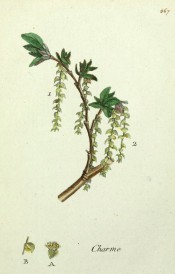Carpinus betulus L.
Medium sized to large deciduous tree with a grey, fluted trunk and ovate, serrate, ribbed leaves and fruiting catkins to 12cm long. Usually keeps its dead leaves through winter. To 20m but often grown as a hedge in a similar way to Beech. An excellent hedging species. [RHSD, Hortus, Hilliers’].
Horticultural & Botanical History
Ancient garden plant. ‘The hornbeam is described as being indigenous from the south-west of France eastwards across central and eastern Europe to Persia, northwards to England and Ireland (but not Scotland) and the southern portion of Sweden, and southwards to lower Italy and Greece. The evidence of historical records goes, however, to prove that it was not originally among the forest trees of England, but was introduced from the Continent before the close of the fifteenth century. Its vertical distribution is limited to about 3,300 feet in the Swiss Alps, 2,900 feet in the Bavarian Alps, 2,600 feet in the Vosges and the Black Forest, and 1,200 feet on the Harz mountains. Although not liable to suffer from cold, it does not stretch far northwards, its growth being practically limited as a forest tree by the German Ocean and the Baltic. It hardly belongs to the ruling species of forest trees, although in eastern Russia, and beyond the Weichsel and the Oder, where the beech ceases to form forests its place is taken to a great extent by the hornbeam, which there attains excellent growth, and covers an area of immense extent. It is prized rather for its toughness and its adaptability to machinery requirements and cogs of wheels, and for its great heating power as fuel, than for any of its other qualities as timber. It is more the denizen of the valleys and the lower uplands than of the higher hill-ranges, which it cannot ascend so far as the beech. It is principally found in groups or patches, or as individual trees interspersed among beech along with oak, lime, ash, and Scots pine on moist patches of soil.’ [Nisbet – British Forest Trees p.272/1893].
Figured in Flora Parisiensis vol.6, pl.567/1783.
History at Camden Park
Carpinus betulus is marked with a ‘c’ in an 1836 edition of Loddiges’ catalogue held at Camden Park [CPA]. In William Macarthur’s code, used and explained elsewhere, this means grown at Camden. It is almost certain that it was grown in the gardens around this time but it did not appear in the catalogues.
Notes
Published Apr 02, 2010 - 12:45 PM | Last updated Apr 02, 2010 - 12:49 PM
| Family | Betulaceae |
|---|---|
| Category | |
| Region of origin | Europe, including Britain, to Asia Minor |
| Synonyms | |
| Common Name | Common Hornbeam |
| Name in the Camden Park Record |
Carpinus betulus |
| Confidence level | high |


